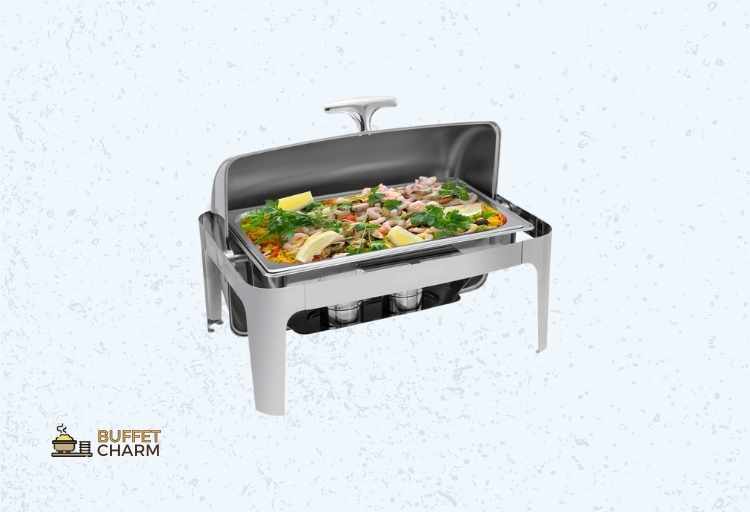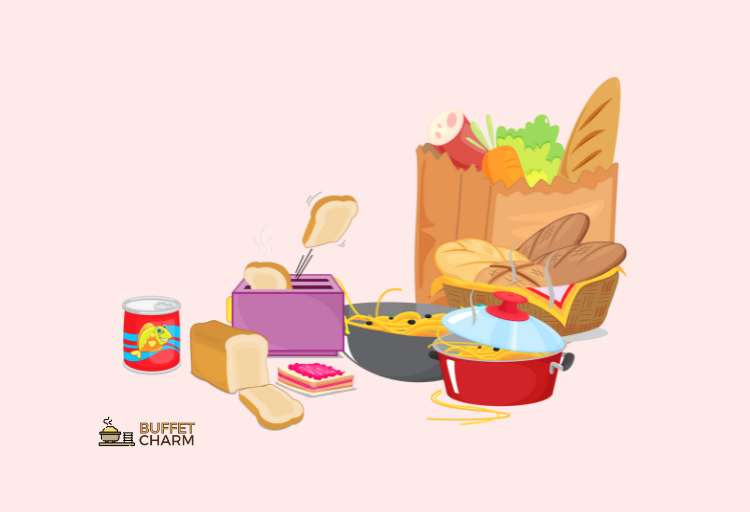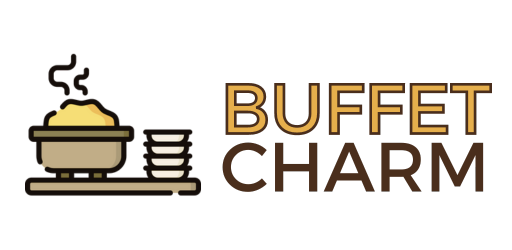How Hot Do Chafing Dishes Keep Food
Food management and warming up during events, parties, or catering services is an art that combines food safety with great cooking. But, how hot do chafing dishes keep food?
Chafing dishes typically maintain food temperatures between 140°F to 165°F (60°C to 74°C), ensuring they stay safe and warm for serving at events.
Every food enthusiast or event organizer understands the importance of keeping food not just warm, but safely heated. Enter the chafing dish—a practical yet elegant solution.

How Hot Do Chafing Dishes Keep Food?
Chafing dish warmers are essential tools for keeping food hot during events or buffet service. They typically maintain food within a safe and appetizing temperature range of 140-165°F (60-74°C). This temperature range is crucial for food safety and quality.
Here’s a detailed explanation:
1. Temperature Range
Chafing dishes utilize a water pan and a food pan. The water pan is filled with hot water and heated by a heat source, such as sterno burners, canned heat, or electric heating elements. This hot water creates steam, which rises and envelops the food in the food pan. The combination of hot water and steam helps to keep the food within the desired temperature range.
2. Safe Food Temperature
The recommended temperature range of 140-165°F (60-74°C) is considered safe for most cooked foods. It prevents bacterial growth and ensures that the food remains safe for consumption. Foodborne pathogens are less likely to thrive in this temperature range.
3. Consistent Heat
Chafing dishes are designed to provide consistent, even heat distribution to the food. This prevents the food from cooling down rapidly and becoming unsafe to eat. The water pan helps maintain a stable temperature by acting as a buffer against rapid temperature fluctuations.
4. Quality Maintenance
In addition to safety, chafing dishes help maintain the quality of the food. Hot foods are more appealing and palatable than lukewarm or cold ones. This is especially important for dishes like gravies, soups, and sauces, where maintaining the right temperature is crucial to their taste and texture.
5. Versatile Use
Chafing dishes are versatile and can be used for various types of food, from main courses to side dishes and desserts. This versatility makes them a popular choice for catering, buffets, and large gatherings.
6. Monitoring
While chafing dishes are effective at keeping food hot, it’s essential to monitor the temperature periodically with a food thermometer to ensure it stays within the safe range. Adjust the heat source as needed to maintain the desired temperature.
Do You Know
If the chafing dish doesn’t keep the food hot enough, there’s a risk of bacteria growing on the food.
Different Heat Sources
While the mission is consistent—keeping food hot—the methods vary:
- Gel or Liquid Fuel Canisters: The traditionalist’s choice, these canisters produce a flame that heats the water pan. They are easy to set up and portable.
- Electrically Heated Chafing Dishes: Modernity meets the chafing dish. These dishes offer consistency, allowing for more precise temperature control without the need for open flames.
- Induction Chafing Dishes: The high-tech choice, of induction dishes, uses magnetic fields to produce heat. While pricier, they offer unparalleled efficiency and safety.
How Does the Type of Food Impact the Warming Process?

The type of food significantly impacts the warming process. Foods vary in density, moisture content, and heat conductivity, all of which influence how they absorb and retain heat.
For instance, denser items like meats may require longer warming times to ensure thorough heating, while moist foods may heat more evenly than dry ones.
Delicate items like fish can overcook quickly, requiring careful monitoring. Therefore, understanding these variations in food properties is essential for effective warming to maintain both safety and food quality.
Why Should You Use Caution When Heating Certain Foods, like Fish?
Because some foods, like fish, are sensitive to heat, you should be careful when heating chafing dishes. Since fish is a delicate protein, it’s easy to cook it too long and lose its taste and texture.
Fish can’t handle as much heat as denser foods can, so they need to be cooked for shorter periods of time at lower temperatures to keep their moisture and tenderness.
Overheating can make a dish look and taste less good, which shows how important precise and careful cooking methods are when making fish.
Difference Between the Water Pan and the Food Pan in a Chafing Dish
The water pan and the food pan are essential components of a chafing dish, each serving a distinct purpose:

Water Pan
- The water pan is placed in the lower part of the chafing dish.
- It is filled with hot water before placing the food pan on top.
- The primary function of the water pan is to create steam when heated.
- This steam rises and envelops the food in the food pan, helping to maintain its temperature.
- The water pan also acts as a buffer against direct heat, preventing the food from scorching or burning.
- It helps maintain a consistent and gentle heat, keeping the food within a safe and appetizing temperature range.
Food Pan
- The food pan is placed above the water pan, resting on a frame or rack within the chafing dish.
- It holds the actual food items you want to keep hot and serve.
- Food pans come in various sizes and materials (e.g., stainless steel, and aluminum) to accommodate different dishes.
- The food pan is where you place the food you wish to keep warm, such as casseroles, soups, sauces, or other prepared dishes.
- It can be covered with a lid or foil to further retain heat and moisture.
Why Should You Cover Food While It’s Warming in a Chafing Dish?
Covering food while it’s warming in a chafing dish serves several essential purposes. Firstly, it helps to retain heat and moisture, preventing the food from cooling down too quickly. This ensures that the food remains within the safe temperature range of 140-165°F (60-74°C), which is crucial for food safety.
Secondly, covering food helps to maintain its quality. Heat-sensitive items like sauces, gravies, and delicate proteins can easily become overcooked or dry out if exposed to open air for an extended period. By covering them, you preserve their texture, flavor, and overall appeal.
Additionally, covering food in a chafing dish prevents contaminants, such as dust or airborne particles, from settling onto the food. This helps maintain food hygiene and presentation standards, particularly during events or buffet services where food is exposed for extended periods.
However, it’s important to leave a small opening or gap when covering food. This allows excess steam to escape, preventing condensation from accumulating on the cover and dripping back onto the food, which could affect its quality. Properly covering food in a chafing dish is a key practice to ensure that it remains both safe to eat and appetizing throughout the duration of an event or service.
How Can You Speed Up Heating in Chafing Dishes?
To expedite heating in chafing dishes, there are a few effective strategies.
- First, consider using additional sterno burners or heat sources to increase heat output.
- Second, use six-hour sterno burners to ensure a steady heat source during extended events.
- Third, periodically stir or mix the food to promote even heating.
- Finally, covering the chafing dish and leaving a small opening can help trap heat, expediting the warming process while maintaining food quality.
These methods collectively accelerate the heating of food in chafing dishes, ensuring it reaches the desired serving temperature more quickly.
Should You Leave a Small Opening While Food Warming in a Chafing Dish?
Yes, it’s advisable to leave a small opening while food is warming in a chafing dish. This small gap allows excess steam to escape, preventing condensation buildup on the cover and maintaining food quality.
It also helps regulate the temperature inside the dish, ensuring that the food remains at the desired serving temperature without overcooking or drying out.
Properly leaving a small opening while warming food in a chafing dish is a key practice to balance heat retention and quality preservation.
Best Practices for Using Chafing Dishes
To maximize the benefits of a chafing dish:
- Stir Frequently: This ensures even heat distribution and prevents food from drying out or overcooking at the bottom.
- Monitor Water Levels: The water pan should be refilled periodically to prevent it from running dry, which could result in uneven heating.
- Heat Source Maintenance: Whether it’s replacing a spent fuel canister or adjusting an electric setting, ensure the heat remains steady.
Conclusion
To sum up, effective food warming and management during events or catering services are crucial for both safety and quality. Chafing dishes play a significant role in this process, keeping food hot within the safe temperature range of 140-165°F (60-74°C).
It’s important to consider the type of food being heated, as different items have varying heat sensitivities. Caution should be exercised, especially with delicate foods like fish, to prevent overcooking.
Chafing dishes consist of a water pan and a food pan, with the former generating steam to maintain consistent heat and moisture. Covering food while warming is recommended to retain heat, preserve quality, and maintain hygiene, but leaving a small opening allows excess steam to escape.
Strategies like using additional heat sources or stirring can speed up the warming process. Properly managing food in chafing dishes ensures that it remains both safe to eat and appetizing throughout the duration of an event.
